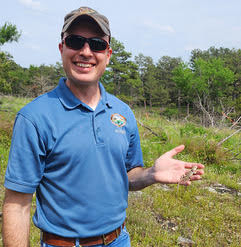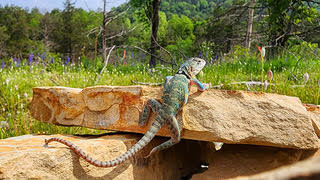

|
Contact: Randy Zellers, (501) 804-8422
LITTLE ROCK — Forty-three eastern collared lizards bred at the Little Rock Zoo found new homes in the Arkansas Ozarks last week thanks to an innovative partnership between the zoo, Arkansas Game and Fish Commission, University of Arkansas, University of Central Arkansas and the Arkansas Cooperative Fish and Wildlife Research Unit.
Sometimes referred to as “mountain boomers,” eastern collared lizards are listed as a species of greatest conservation need in Arkansas. They are some of the largest lizards found in Arkansas with some males reaching 14 inches long. These native lizards are particularly striking with vibrant yellow, green and teal blue colors in males and females sporting more muted greens with red-orange markings. The species has experienced declines in the last few decades, primarily as a result of the loss of sparse, rocky glades. Suppression of fire along many of these thin-soiled mountain areas has allowed cedars and other woody plants to invade these spaces, changing the plant communities required by animals that historically called them home.
While not the first attempt at relocation of eastern collared lizards, which are listed as a species of greatest conservation need in Arkansas, this is the first time researchers and biologists have collaborated with the zoo to provide yearlings to introduce in newly restored habitat. According to the AGFC’s code of wildlife regulations, release of any animals into the wild is illegal unless done with prior permission from AGFC, so the agency worked very closely with the zoo to collect lizards to be bred at the zoo and then release their yearling offspring into the proper habitat once the zoo had hatched and raised them.
The Collared Lizard Conservation Team, as well as several other federal, state and private agencies have been focused on restoring glade habitat throughout the state to benefit many species, including northern bobwhite, wild turkey and several glade endemic plants, arthropods and vertebrates. Restoration efforts include prescribed fire, cedar removal, invasive plant treatments, prairie plant reseeding and the addition of large rock piles (the primary refuge for many glade species).
For the last year, the conservation partners have worked on collaborative efforts including a captive propagation program at the zoo to provide lizards for reintroductions to restored habitat sites. Last week’s release was the first of many planned for the future to re-establish this valuable Arkansas treasure to the landscape before it is too late.
The team anticipates reintroducing several more populations to other locations in the state, which will include State Parks, AGFC and private land.
Contact Dr. Casey Brewster at clbrewst@uark.edu or Dr. Matt Gifford at megifford@uca.edu for more information about the Collared Lizard Conservation Team and this effort. For more information on how to re-establish native habitat on your property, visit www.agfc.com/habitat.